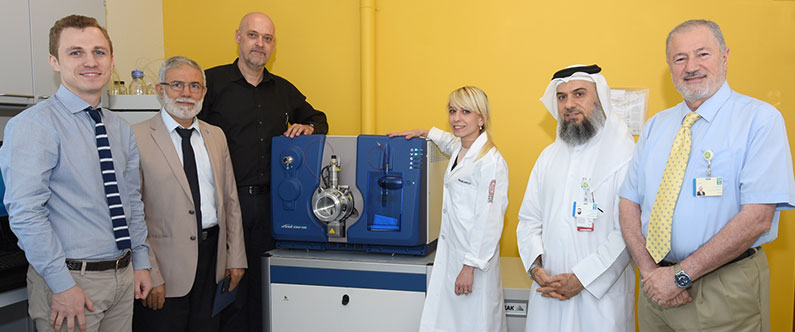Joint research study by WCM-Q and HMC looks at using saliva to test for diabetes
 The joint research team from Hamad Medical Corporation and Weill Cornell Medicine-Qatar.
The joint research team from Hamad Medical Corporation and Weill Cornell Medicine-Qatar.
Early diagnosis and treatment is vital for patients with diabetes as it can significantly reduce the risk of developing complications but traditional tests are invasive and rely on taking blood samples.
However, scientists from Weill Cornell Medicine-Qatar (WCM-Q) and Hamad Medical Corporation (HMC) previously identified a biomarker (metabolite 1,5-anhydroglucitol – 1,5AG) that would allow for a non-invasive screening and monitoring of the disease from saliva. They are now working together to translate this knowledge into a test that can be used in a clinical setting. Using saliva rather than blood to monitor glucose levels would benefit the patient as it has the potential to offer a painless screening method for routine testing.
“Testing for diabetes using saliva, and not blood, is far less invasive and significantly improves the screening process for many patients. This is especially true for children who may be reluctant to have blood taken,” said Professor Abdul-Badi Abou-Samra, chairman of internal medicine at HMC, director of the Qatar Metabolic Institute and one of the study investigators. “The development of new sensitive screening tools is very important in the fight against diabetes. It could help identify undiagnosed diabetic and pre-diabetic patients, resulting in improved management and reduced complications.”
The collaborative team of researchers from WCM-Q, led by Dr. Karsten Suhre, professor of physiology and biophysics and director of the Bioinformatics Core at WCM-Q, and the team from HMC, led by Dr. Ramzi Mohammad, director of the interim Translational Research Institute (iTRI), is continuing the project to assess the viablility of non-invasive monitoring and screening of diabetes, although a direct translation of the initial findings into the clinics is yet to be seen.
The research published in the Journal of Translational Medicine demonstrated that measurements of 1,5-AG in saliva is feasible in clinical settings becaouse saliva is providing a stable environment for the biochemical test. They also identied another molecule that interferes with the test readouts and limiting the measurements. Therefore, current efforts are focused on optimizing the test by introducing an enzymatic reaction to remove the interference and enable the direct use of patient’s saliva for the test.
The study was supported by HMC’s Medical Research Center. Dr. Ibrahim Janahi, executive director of MRC and professor of pediatrics at WCM-Q, said:
“This was a truly collaborative and productive project. It illustrates how an excellent research outcome can derive from the partnership between HMC and WCM-Q.”
Dr. Karsten Suhre added:
“For us at WCM-Q, collaborating closely with HMC gives us the opportunity to translate our research from the laboratory to the clinic where it can be of practical use. Translational research of this type is a key priority for Qatar and we are very happy to be working with our colleagues at HMC who are always keen to develop new techniques to continuously improve the care they provide to their patients”.
Dr. Anna Halama from WCM-Q and Dr. Michal Kulinski from the iTRI, who both conducted the research, are now working on the next important project - implementation of the first targeted metabolomics platform in Qatar, meaning fewer samples will have to be sent abroad for analysis.